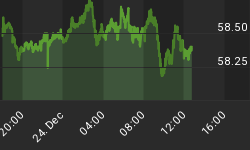FOMC minutes for the January meeting were released on Wednesday. Inflation was cited as the "predominant concern." The Fed noted that it "did not yet see a downtrend in core inflation as definitively established." Fed officials felt that "resource utilization was elevated" and "labor markets remained relatively taut" and thought "labor cost might rise more rapidly." Since the Fed meeting, there have been some indications that these concerned have moderated, but not by much. The Labor Department reported that the unemployment rate ticked up to 4.6%. Additionally, industrial production waned and capacity utilization eased to 81.2%, which was the lowest since last February.
Consumer prices rose 0.2% in January, higher than the 0.1% increase economists expected. Compared to last year, prices rose 2.1%. Excluding food and energy, prices rose 0.3% from December and 2.7% over the past year. While the increase in consumer prices was lower than the peak reached in September last year, the increase highlighted the fact the inflation concerns have not diminished. Rents increased 4.8%, breaking a stretch of three months of slowing rent increases. Owners equivalent rent remained 4.3% higher year-over-year, the same increase as the past two months. Interestingly, Sam Zell, was interviewed by Bloomberg and said that residential rents could jump double-digits this year as marginal homeowners move back into apartments.
The composition of the rise in the CPI does not bode well for the upcoming PCE deflator. Merrill Lynch's David Rosenberg noted that while the CPI was "rather benign...the components bode ill for the upcoming core PCE deflator." Since the Fed focuses on the PCE more than CPI, poses a short-term risk to the bond market. Rosenberg pointed to two factors that could cause the PCE to be higher than the 0.2% currently expected. First, medical care prices jumped 0.8% in January. This accounts for only 8% of the core CPI, but 25% of the core PCE. Additionally, apartment rents and owners equivalent rent account for 38% of the core CPI, but only 17% of the core PCE and these prices increased only 0.3% and 0.2% respectively. The end result of this is a large likelihood that the core PCE will be 0.3%, which hasn't happened since March 2006. Plus there is a chance that it comes in at 0.4%, which has only happened three times in the past twelve years.
Retail sales continued to decelerate last week. The ICSC reported that chain store sales increased 3.5% last week, which is the third consecutive week of lower growth from a peak of almost 5% last month. Some of the weakness can be attributed to the weather as snow storms hit much of the Northeast. The trade group expects sales for the full month to be only 3.0%, down from 3.7% last month. Some of this weakness might be confined to Wal-Mart.
Wal-Mart reported that fourth quarter earnings per share increased 10.5% to $0.95. This was a nickel ahead of estimates and three cents better than the top end of Wal-Mart's guidance. Sales increased 11%, mainly due to new stores as same store sales increased only 1.6%. Sam's Club boosted same store sales by 3.1%, while the Wal-Mart division experienced a 1.3% increase. Positive food comps were able to offset negative comps in general merchandise. Gross margins increased 30 basis points to 17.41%, mainly due to its international operations. The company did say that it did benefit from higher initial markups in the US. Total operating expenses increased 36 basis points due to remodeling activity and higher advertising expense. Analysts were impressed by Wal-Mart's inventory control. Inventory increased only 5.6%, about half the rate sales increased.
The slowdown in residential housing has impacted Home Depot. The leading home improvement retailer reported that fourth quarter earnings dropped 17% on a 4% increase in revenue. Same store sales fell 6.6% and decelerated sharply in January, down 11.4%. Sales in its supply business increased 64%, but this was entirely due to acquisitions. Organic growth dropped 6.9% "driven primarily by the soft residential construction market."
Abercrombie & Fitch reported that fourth quarter earnings per share increased 20% to $2.14. Sales increased 18% due to new store openings; same store sales dropped 3%. Similar to other retailers, Abercrombie noted that the weather was a factor in its results. The company said that first quarter earnings would increase "mid-single-digit" due to higher expenses to open its London store. This is below analyst estimates of 11% growth. It also said that its baseline plan calls for flat same store sales this year.
The likelihood of the Fed cutting rates during the first half of the year has vanished. Everyone seems focused on resource utilization, but the manufacturing sector is a small part of the economy and not indicative of end demand. Total vehicle sales last year were 16.6 million, down only 2.5% from last year, but domestic auto production fell 5.4%. Consumer spending and the service sector are the real drivers of the economy. As long as consumers maintain their spending habits, the economy should continue to expand. We, along with almost everyone else, initially thought the slowdown in the housing market could cause consumers to retrench. This certainly has not happened yet. The Fed cannot focus on a narrow segment of the economy and lower rates based on a few automotive and furniture plants closing. If it does, it will certainly throw more fuel on the rest of the economy that has been able to expand.
















